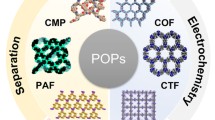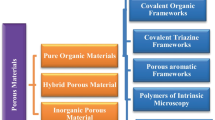Abstract
By adopting “grafting from” manner, polystyrene was grafted onto the surface of silica gel particles with an average size of 125 μm in a solution polymerization system, and grafted particle PSt/SiO2 was prepared. Using 1,4-bis (chloromethoxy) butane (BCMB, it is nontoxic.) as chloromethylation reagent, chloromethylation reaction for the grafted particle PSt/SiO2 was performed in the presence of Lewis acid catalyst SnCl4. At the same time, cross-linked styrene-divinylbenzene copolymer (CPS) microsphere also was chloromethylated with the same reagent as PSt/SiO2, so that two kinds of chloromethylated polystyrene particles were obtained, and they are chloromethylated grafted particle (CMPS/SiO2) and chloromethylated cross-linked polystyrene (CMCPS) microsphere, respectively. The chemical structures and compositions of the two particles were characterized using Fourier transform infrared and Volhard method. The effects of various factors on the chloromethylation reactions were mainly investigated. The experimental results show that the process to prepare the two kinds of chloromethylated polystyrene particles not only has the character of environment friendness and low cost but also is convenient to control via adjusting various reaction conditions. The main reaction conditions affecting the chloromethylation reactions are reaction time, the added amount of BCMB, and the used amount of solvent and catalyst. They influence the reaction in two respects: (1) the chloromethylation degrees of polystyrene are different under different conditions; (2) Friedel–Crafts cross-linking reaction between polystyrene macromolecules is accelerated or inhibited under different conditions (for CPS microsphere, this cross-linking reaction also is called the additional cross-linking). Under suitable conditions, the two kinds of chloromethylated polystyrene particles with a high chlorine content (about 17%, this chlorine content was calculated based on polystyrene weight) can be gained using SnCl4 as catalyst and CH2Cl2 as solvent at room temperature for 10 h and basically without cross-linking or additional cross-linking.












Similar content being viewed by others
References
Wang Y, Zhang G-H-, Yan H-S et al (2006) Tetrahedron 62:4948–4953
Arunan C, Nagaraj R, Rajasekharan Pillai VN (2000) Peptides 21:773–777
Xu M-C, Ou Zh-Z, Shi Z-Q et al (2001) React Funct Polym 48:85–95
Masuda T, Kitahara K-I, Aikawa Y, Arai S (2002) J Chromatogr A 961:89–96
Jain VK, Pandya RA, Pillai SG, Shrivastav PS (2006) Talanta 70:257–266
Mondal BC, Das AK (2002) React Funct Polym 53:45–52
Marquès G, Bourdelande JL, Valiente M (1999) React Funct Polym 41:77–89
Maurya MR, Kumar M, Sikarwar S (2006) React Funct Polym 66:808–818
Moghadam M, Tangestaninejad S, Mirkhani V et al (2005) Bioorganic Med Chem 13:2901–2905
Sophiamma PN, Sreekumar K (1997) React Funct Polym 35:169–177
Kedem M, Margel S (2002) J Polym Sci A Polym Chem 40:1342–1352
Khan AA, Abdelaal MY, Ali MM, Abdel-Latiff EH (1998) Polymer 40:233–241
Jang BB, Lee K, Kwon WJ, Suh J (1999) J Polym Sci A Polym Chem 37:3169–3177
Jang BB, Lee K, Kwon WJ, Suh J (1999) J Polym Sci A Polym Chem 37:3169–3177
Carre EL, Lewis N, Ribas C, Wells A (2000) Org Process Res Dev 4:606–610
Kavaklı C, Özvatan N, Tuncel SA, Salih B (2002) Anal Chim Acta 464:313–322
Unsal E, Bahar T, Tuncel M, Tuncel A (2000) J Chromatogr A 898:167–177
Shen Y-L, Yang Y-F, Gao B-J, Zhu Y (2007) Acta Polymerica Sinica 6:531–537 (in Chinese)
Shen Y-L, Yang Y-F, Gao B-J, Li G (2007) Chem J Chin Univ 28(3):559–565 (in Chinese)
Gao B-J, Wang R-X, Jiu H-F, Kong D-L (2006) J Appl Polym Sci 102:5808–5817
Author information
Authors and Affiliations
Corresponding author
Rights and permissions
About this article
Cite this article
Lü, C., Gao, B., Liu, Q. et al. Preparation of two kinds of chloromethylated polystyrene particle using 1,4-bis (chloromethoxy) butane as chloromethylation reagent. Colloid Polym Sci 286, 553–561 (2008). https://doi.org/10.1007/s00396-007-1800-z
Received:
Revised:
Accepted:
Published:
Issue Date:
DOI: https://doi.org/10.1007/s00396-007-1800-z




